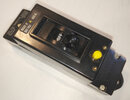Hello chaps
I have an old CU that I want to replace with a modern unit. This is a TT system with an earth spike driven into the ground and a voltage operated earth leakage device installed.
My question is on the new installation can I just leave that VOELCB in place so that I don't have to call in the network operator to pull the main fuse.
Thanks in advance - Stuart
I have an old CU that I want to replace with a modern unit. This is a TT system with an earth spike driven into the ground and a voltage operated earth leakage device installed.
My question is on the new installation can I just leave that VOELCB in place so that I don't have to call in the network operator to pull the main fuse.
Thanks in advance - Stuart



